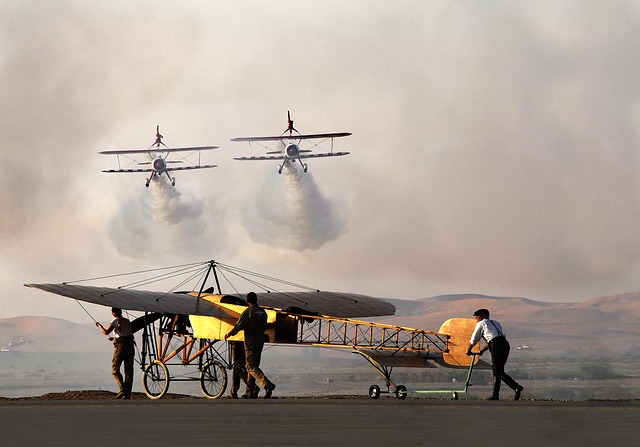
A Sector's Successes
The 6 Most Impressive Feats of Aerospace Engineering
Read a summary using the INOMICS AI tool
Humankind has always been fascinated by flight. Many an inventor has looked at how effortlessly birds float on the wind and wondered if a similar feat can be achieved by using only human ingenuity. The chances are high that you are reading this article because you too have an interest in all things aeronautical. This article lists some of the more impressive feats that have been achieved thus far and aims to instil a sense of awe.
 Invention of Flight
Invention of Flight
It would be completely irrational to begin a list of aerospace achievements without starting with the Wright brothers, the pioneers of powered flight. It must be noted that the brothers weren’t the first to achieve manned flight; various daring inventors and engineers took to the skies in anything from hot air balloons to gliders long before the Wrights took to the skies. However, the Wright brothers were the first to achieve four key requirements that set humanity free amongst the clouds. Their maiden flight was manned, self-powered, heavier than air and controlled (somewhat). This iconic 12 second flight served as the spring board for all the other feats listed below.
First person in space
One of the most impressive feats of humanity was the launching of Russian Cosmonaut, Yuri Gagarin, into space on the 12th of April 1961. Yuri was strapped into a tiny capsule, Vostok 1, and blasted into orbit where he completed nearly one full orbit of the earth before landing safely back on earth. He was the first conscious being to observe the earth from the cold darkness of space. This feat was achieved during the decade long space race between the then Soviet Union and the United States of America. The space race was ultimately won by the USA.
Apollo Program
Despite all the other impressive feats listed in this article, nothing comes close to the moon landings. Never would anyone of dreamt that one day humankind would set foot upon the surface of the moon. The technical prowess employed to build the machines to send people to the moon and back is staggering to this day. The Saturn 5 rocket was a 10m diameter, 110m tall behemoth that had a thrust of 33400 kN and could send 43 tons to lunar orbit. To put this in perspective, the most powerful rocket currently flying has a thrust of 22819 kN and can launch 16 tons to lunar orbit. There was a total of 6 missions to the surface of the moon starting on July 20, 1969. No one has returned ever since.
Voyager probes
The voyager program was developed to collect scientific data on Saturn and Jupiter, and voyager 2 went on to explore both Uranus and Neptune. On board both voyagers, was a gold plated record imprinted with various mathematical symbols and contained sounds and images. The voyagers were sent on a trajectory that would take them out of the solar system. The 2 craft are the farthest ever manmade objects from earth, and are capable of travelling at a speed of 56 000 Kph. This may seem fast, but at this speed it would take 40 thousand years to reach our closest neighbouring star, hundreds of millions of years to reach the closest edge of our Milky Way galaxy, and if you were to try and travel to the Andromeda galaxy (our nearest galaxy), it would take longer to get there than the universe is old. It must be noted that practically speaking, the probes will never escape the Milky Way as their velocity does not exceed the local escape velocity of our galaxy.
Re-useable Rockets
Very few have not heard of Elon Musk and SpaceX. SpaceX is pioneering reusable spaceflight and has innovated at such a breakneck pace that they do not currently have any serious competitors. Watching a massive rocket autonomously land upright on a ship in the middle of the ocean is probably the most impressive technical achievement in recent memory. The falcon heavy was launched in February 2018 and is currently the most powerful operational rocket on the planet. It can launch 63 tons to low earth orbit and 16 tons to mars. The maiden flight of the falcon heavy launched a tesla roadster into the black of space.
Solar Impulse
The solar impulse is an aircraft that can fly using only the energy collected from solar panels. During the day the solar panels charge batteries and power the engines and at night the batteries power the engines. Theoretically, such a craft can stay aloft indefinitely but due to both mechanical and biological limitations, the craft will always need to land eventually. In 2015 the solar impulse 2 completed a round the world flight without using a single drop of fuel. This incredible achievement is paving the way to a more energy efficient and sustainable future.
In Conclusion
The aerospace field is an incredibly diverse and rewarding industry where the limits are being continuously pushed to new extremes. The feats listed in this article are only a drop in the ocean and the future of aerospace is an exciting one. Leonardo Da Vinci said it best; ‘Once you have tasted flight, you will forever walk the earth with your eyes turned skyward, for there you have been, and there you will always long to return.’









